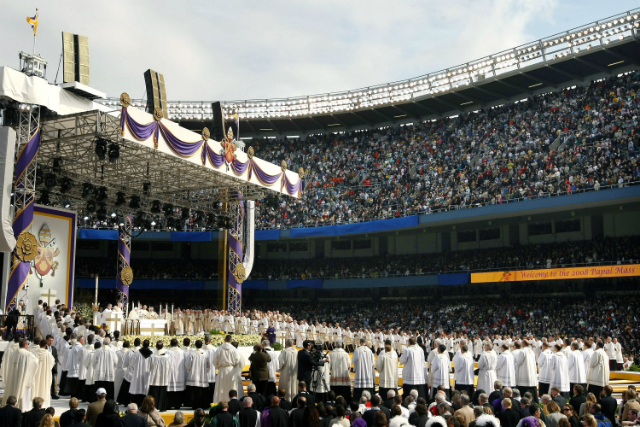Pope Francis lands at John F. Kennedy International airport this Thursday for his brief visit, but pope-mania hit New York City weeks ago when the city organized a lottery for tickets to the 78-year-old pontiff's upcoming procession through Central Park. It received 93,143 ticket requests for 40,000 pairs of tickets.
Francis' humility, his progressive views and his engaging presence have made him one popular Holy Father. According to Pew Research Center polls, his popularity in February reached 90 percent among Catholics and 70 percent among the general public. And a papal visit to New York City has always seemed to drive New Yorkers into a frenzy.
We've taken an in-depth look back at the past two times Bishops of Rome graced the Big Apple with their holy presence. (Francis' visit marks the fifth time a pope has visited New York.) Some conclusions: this will be the third time a pope presides over services at St. Patrick's Cathedral; Francis will be the fourth pope to visit the United Nations in its 70-year history, following the examples of Pope John Paul II and Pope Benedict XVI; and no security measure is too extreme to keep to keep the pope safe.
Pope John Paul II, who died in 2005, last visited New York City in October 1995.
► THE SECURITY PREPARATIONS: John Paul II arrived in the city for his second and final visit to the metropolis Oct. 4, 1995. In anticipation of the event, the city removed garbage cans that could conceal hidden bombs from Central Park, where the pope would celebrate Mass. Barriers of sand-filled garbage trucks were installed between 72nd Street and at the pope's temporary quarters at the residence of the United Nations' Vatican delegation on East 72nd Street between Madison and Fifth avenues. The city also barred air traffic over New York, such as commercial flights and tourist helicopters, from areas where the pontiff was traveling or speaking.

Pope John Paul II rides in his Popemobile (Getty/Salah Malkawi)
► THE LOGISTICS: When he wasn't cruising around in his bulletproof Popemobile, a precaution he began taking after an assassination attempt in 1981, the pontiff traveled by Marine Corps helicopter.
► THE ITINERARY: On Oct. 5, the Holy Father visited the United Nations, where he addressed the General Assembly and called on the world's nations to live up to their moral responsibilities. On Oct. 6, the pontiff celebrated Mass at the Aqueduct Race Track. On the morning of the next day, he celebrated another Mass before more than 125,000 people gathered on the Great Lawn in Central Park. Later that Saturday, he recited the rosary with more than 3,000 invited guests at St. Patrick's Cathedral in Midtown.
► THE HIGHLIGHT: Despite the 1981 assassination attempt and the lingering effects of a leg fracture that had forced him to cancel the previous year's trip, the pope walked down St. Patrick's central aisle and took an unexpected stroll on the streets of New York. Breaking out from behind his bulletproof shields and security men, the pope reached out to the worshippers gathered, making the sign of the cross over some, laying a hand in blessing over others, and kissing children's heads.
Pope Benedict XVI, who resigned in 2013, visited New York City in April 2008.
► THE SECURITY PREPARATIONS: The Secret Service, the New York Police Department and the pope's own Swiss Guard security forces planned to sweep all the stops on Pope Benedict's itinerary for bombs. Other measures to protect the pontiff included: scuba divers in the East River, counter-snipers patrolling rooftops, helicopters, undercover detectives in crowds, officers carrying small radiation detectors on their belts, metal detectors, bag searches, and a ban on air traffic below 3,000 feet at three locations.
► THE LOGISTICS: The pope arrived in the city April 18 and stayed in the same residence as Pope John Paul II did, where the Vatican's representative to the U.N., Archbishop Celestino Migliore, was then living.
► THE ITINERARY: The morning of April 18, the pope spoke at the United Nations, where he urged the world to work toward peace through the advancement of human rights, rather than political force. He then visited the Park East Synagogue on the Upper East Side. The next day, he celebrated Mass at St. Patrick's in the morning and later traveled to St. Joseph’s Seminary in Yonkers, where he participated in a youth rally. On Sunday, the leader of the Catholic Church blessed the site of the former World Trade Center, clasping the hands of survivors and relatives of those who died on 9/11, and celebrated Mass with 60,000 people at Yankee Stadium, where the team asked him to keep his Popemobile off the grass.

Pope Benedict XVI celebrates Mass at Yankee Stadium (Getty/Chris McGrath)
► THE HIGHLIGHTS: Pope Benedict's visit to the Park East Synagogue was the first by a pope to an American synagogue. Said the rabbi who welcomed him: "Both of us have experienced the ravages of war, the Holocaust, the inhumanity of man to man, but we have also tasted the joy of freedom." (Pope Benedict, who grew up in Nazi Germany, deserted the German army before the end of World War II.)
The following day, during St. Patrick Cathedral's first papal Mass, the Holy Father called for a time of healing after the exposure of a sex-abuse scandal in which clergy members had been caught abusing children; the message had, by then, already become a motif of the papal tour.
Our retrospective of the past two papal visits to New York City was compiled from articles by Newsday's Robert E. Kessler, the Atlanta Journal-Constitution's David Ho, the New York Times' Andrea Mohin, Ian Fisher, Al Baker, Don Van Natta Jr. and Sewell Chan, the Boston Globe's Michael Levenson, the St. Petersburg Times' Lisa Buie, the Oakland Tribune's Michael Collins, USA Today's Cathy Lynn Grossman, and the Chicago Sun-Times' Andrew Herrman.


























